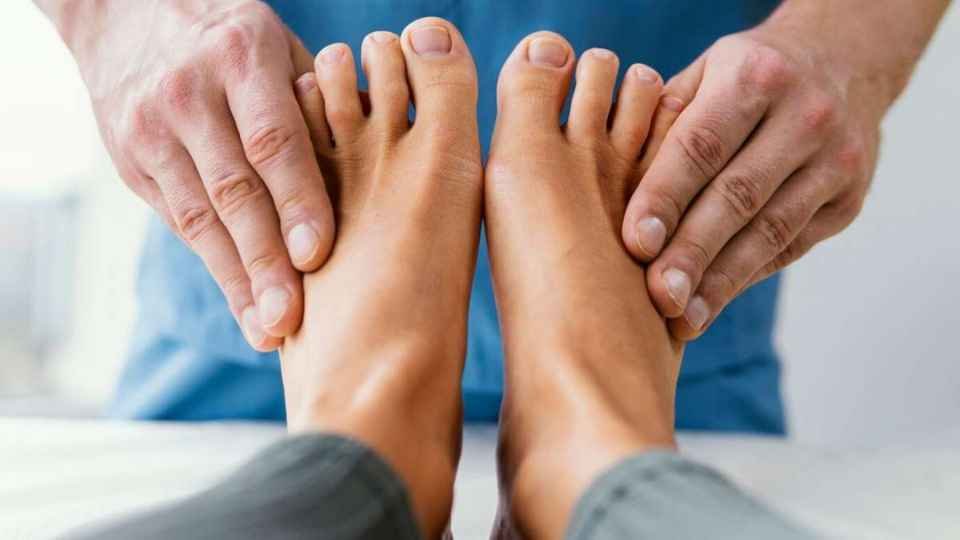Wearing Socks to Washing Feet: Expert Shares Crucial Tips for Diabetic Foot Care – Diabetes is a complex metabolic disorder characterized by high blood sugar levels over a prolonged period. While its management involves various aspects, one often overlooked yet critical area is foot health. The feet of individuals with diabetes are particularly vulnerable to complications due to two primary factors: reduced blood circulation and nerve damage, a condition known as diabetic neuropathy.

Wearing Socks to Washing Feet: Expert Shares Crucial Tips for Diabetic Foot Care
Reduced blood circulation, or peripheral arterial disease (PAD), occurs when blood vessels narrow and restrict blood flow to the extremities, including the feet. This diminished blood supply deprives the feet of essential oxygen and nutrients, impairing the body’s ability to heal wounds and fight off infections. As a result, even minor injuries, such as blisters or cuts, can escalate into serious infections or non-healing ulcers, a condition known as diabetic foot ulcers.
Moreover, diabetic neuropathy, caused by prolonged exposure to high blood sugar levels, damages the nerves in the feet. This neuropathy reduces sensation, leading to a loss of feeling in the feet or decreased ability to perceive pain, temperature, or pressure. Consequently, individuals with diabetic neuropathy may not notice injuries or trauma to their feet, allowing problems to escalate unnoticed until they become severe.
However, with diligent care and attention, individuals with diabetes can mitigate these risks and maintain optimal foot health. This entails a multifaceted approach that encompasses daily foot inspections, proper hygiene, careful nail care, appropriate footwear selection, and consistent blood sugar management.
Daily foot inspections are paramount for early detection of any abnormalities, such as cuts, blisters, redness, or swelling. By examining their feet regularly, individuals can identify issues promptly and seek medical attention before they worsen.
Proper foot hygiene, including daily washing and thorough drying, helps prevent infections. Moisturizing the feet regularly prevents dryness and cracking, reducing the risk of skin breakdown and infection.
Careful nail care, such as trimming toenails straight across and avoiding cutting them too short, prevents ingrown toenails and potential infections.
Selecting appropriate footwear is crucial for diabetic foot health. Shoes should provide adequate support, cushioning, and protection, with a wide toe box to prevent rubbing and irritation. Avoiding high heels, tight-fitting shoes, and shoes with seams or rough edges inside reduces the risk of blisters and other foot problems.
Consistently managing blood sugar levels through medication, diet, exercise, and regular monitoring is fundamental for preventing diabetic complications, including foot problems. Stable blood sugar levels promote overall health and reduce the risk of nerve damage and circulation problems.
In this blog post, we’ll delve into some expert tips for diabetic foot care, covering everything from wearing socks to washing feet.
1. Choose the Right Socks:
Socks play a crucial role in diabetic foot care, serving as a protective barrier between the feet and the shoes while also helping to maintain proper foot hygiene. Here’s why selecting the right socks is paramount for individuals with diabetes:
Material Matters: Opt for socks made from materials that wick moisture away from the skin, such as cotton or moisture-wicking synthetic blends. Moisture-wicking socks help keep the feet dry, reducing the risk of fungal infections and skin irritation. Moisture retention can exacerbate skin issues, particularly in individuals with diabetes who may be prone to dry skin and foot ulcers.
Avoid Tight Elastic Bands: Socks with tight elastic bands can constrict blood flow, compromising circulation to the feet. Restricted blood flow exacerbates existing circulation issues, such as peripheral arterial disease (PAD), commonly associated with diabetes. Choosing socks with non-binding tops ensures optimal blood flow to the feet, reducing the risk of complications such as ulcers and infections.
Seamless Design: Seamless socks are highly recommended for individuals with diabetes as they minimize friction and rubbing against the skin. Seams can cause irritation and abrasions, leading to blisters and skin breakdown, particularly in sensitive or neuropathic feet. Seamless socks provide a smooth surface that reduces the risk of friction-related injuries, promoting overall foot comfort and health.
Cushioning and Support: Look for socks with adequate cushioning in the sole and heel areas to provide additional comfort and protection against pressure points. Cushioned socks help distribute pressure evenly across the foot, reducing the risk of developing calluses, corns, and ulcers. Additionally, socks with arch support can improve foot stability and reduce fatigue during prolonged periods of standing or walking.
Proper Fit: Ensure that socks fit properly without being too tight or too loose. Ill-fitting socks can cause wrinkles or folds, leading to pressure points and potential skin damage. Opt for socks with a snug but not restrictive fit to maintain comfort and prevent slippage or bunching inside the shoes.
2. Inspect Your Feet Daily:
Regular foot inspections are fundamental for individuals with diabetes to detect any potential issues early and prevent complications. Here’s why daily foot inspections are crucial and how to incorporate them into your routine:
Early Detection: Regular foot inspections allow for the early detection of any abnormalities or changes in foot health. Individuals with diabetes are prone to nerve damage (neuropathy), which can lead to decreased sensation in the feet. Consequently, they may not notice minor injuries, such as cuts, blisters, or abrasions, that could progress into serious complications if left untreated. By conducting daily foot checks, any issues can be identified promptly, enabling timely intervention and preventing the development of more severe problems.
Prevention of Complications: Diabetes can impair circulation to the extremities, including the feet, increasing the risk of poor wound healing and infections. By inspecting the feet daily, individuals can identify signs of potential complications, such as redness, swelling, or signs of infection, and take proactive measures to address them. Early intervention, such as cleaning and dressing wounds or seeking medical attention, can prevent complications such as foot ulcers or cellulitis.
Incorporating into Daily Routine: Set aside a specific time each day to thoroughly inspect your feet. Choose a time when you are relaxed and can devote adequate attention to the task. For example, you may choose to conduct foot inspections after showering or before bedtime. Make it a habit to inspect both the tops and bottoms of your feet, as well as between the toes, using a mirror if necessary to view areas that are difficult to see.
Signs to Look For: During the foot inspection, be vigilant for any signs of concern, including cuts, scrapes, blisters, calluses, redness, swelling, or changes in skin color or temperature. Also, be mindful of any unusual sensations, such as tingling, numbness, or burning, which may indicate nerve damage. If you notice any abnormalities, take note of them and take appropriate action, such as cleaning and dressing wounds or contacting a healthcare professional for further evaluation.
Seek Assistance if Needed: If you have difficulty seeing the bottoms of your feet or performing the inspection independently, don’t hesitate to ask for assistance from a family member, caregiver, or healthcare provider. They can help ensure thorough examination and early detection of any issues that may arise.
3. Wash Your Feet Properly:
Proper foot hygiene is paramount for individuals with diabetes to prevent infections and maintain overall foot health. Here’s why washing your feet properly is essential and how to incorporate it into your daily routine:
Prevention of Infections: Washing your feet daily helps remove dirt, sweat, and bacteria that can accumulate throughout the day. For individuals with diabetes, maintaining clean feet is crucial for preventing infections, particularly in the presence of neuropathy or compromised circulation, which can increase susceptibility to foot problems. By practicing good foot hygiene, you can reduce the risk of common diabetic foot complications, such as athlete’s foot, fungal infections, and bacterial infections.
Use Lukewarm Water and Mild Soap: When washing your feet, use lukewarm water and a gentle, pH-balanced soap. Avoid using hot water, as it can dry out the skin and exacerbate existing issues such as dryness and cracking. Harsh soaps and cleansers can strip the skin of its natural oils, leading to dryness and irritation. Opt for mild, fragrance-free soaps specifically formulated for sensitive skin to minimize the risk of irritation or allergic reactions.
Thorough Drying: After washing your feet, be sure to dry them thoroughly, paying particular attention to the areas between the toes. Moisture trapped between the toes provides an ideal environment for the growth of bacteria and fungi, increasing the risk of infections such as athlete’s foot. Use a soft towel to gently pat your feet dry, avoiding vigorous rubbing, which can cause skin irritation. If necessary, use a hairdryer on a low or cool setting to ensure complete drying, especially in hard-to-reach areas.
Avoid Soaking Feet for Prolonged Periods: While soaking your feet can help soften calluses and relieve discomfort, it’s essential to avoid prolonged soaking, particularly for individuals with diabetes. Extended exposure to water can strip the skin of its natural oils, leading to dryness and increased vulnerability to skin problems. Instead, limit foot soaking to short periods and follow up with thorough drying and moisturization to maintain skin health and integrity.
Incorporate into Daily Routine: Make foot washing a part of your daily hygiene routine, ideally during your daily shower or bath. Set aside dedicated time to cleanse your feet thoroughly, ensuring that you reach all areas, including the soles, heels, and between the toes. By integrating foot washing into your daily routine, you can maintain clean, healthy feet and reduce the risk of infections and complications associated with diabetes.
4. Moisturize Regularly:
Keeping your feet moisturized is essential for individuals with diabetes to prevent dry, cracked skin and reduce the risk of infections. Here’s why regular moisturization is crucial and how to do it safely:
Prevention of Dry, Cracked Skin: Diabetes can lead to impaired circulation and nerve damage, resulting in decreased sweat and oil production in the feet. As a result, individuals with diabetes are prone to dry, cracked skin, particularly on the heels and soles. Dry, cracked skin provides an entry point for bacteria and fungi, increasing the risk of infections such as athlete’s foot and foot ulcers. By moisturizing regularly, you can maintain skin hydration, prevent dryness, and reduce the risk of skin breakdown and infections.
Choose a Gentle Moisturizer: When selecting a moisturizer for your feet, opt for a gentle, hypoallergenic formula specifically formulated for sensitive skin. Look for moisturizers that contain ingredients such as glycerin, hyaluronic acid, or urea, which help attract and retain moisture in the skin. Avoid products containing harsh chemicals, fragrances, or alcohol, as these can irritate the skin and exacerbate existing issues. Test a small amount of the moisturizer on a patch of skin before applying it to your feet to check for any adverse reactions.
Avoid Moisturizing Between the Toes: While it’s important to keep the skin on your feet moisturized, avoid applying moisturizer between the toes. Moisture trapped between the toes can create a breeding ground for bacteria and fungi, increasing the risk of infections such as athlete’s foot and fungal nail infections. Instead, focus on moisturizing the tops and bottoms of your feet, paying extra attention to dry or rough areas, such as the heels and soles.
Consult a Podiatrist for Callus or Corn Removal: If you have calluses or corns on your feet, it’s essential to seek professional care from a podiatrist for safe removal. Attempting to remove calluses or corns at home using sharp tools or chemicals can lead to skin damage, infections, and other complications, particularly for individuals with diabetes who may have impaired healing. A podiatrist can safely remove calluses or corns using sterile instruments and provide recommendations for preventing their recurrence, such as proper footwear and padding.
Incorporate into Daily Routine: Make moisturizing your feet a part of your daily self-care routine, ideally after bathing or showering when the skin is clean and hydrated. Apply a generous amount of moisturizer to the tops and bottoms of your feet, gently massaging it into the skin using circular motions. Take care to cover any areas of dry or rough skin thoroughly. Repeat this process daily to maintain optimal foot hydration and prevent dryness and cracking.
5. Trim Your Nails Carefully:
Proper nail care is essential for individuals with diabetes to prevent complications such as ingrown toenails, infections, and foot ulcers. Here’s why trimming your nails carefully is crucial and how to do it safely:
Prevention of Ingrown Toenails: Ingrown toenails occur when the edges of the nails grow into the surrounding skin, leading to pain, inflammation, and potential infection. Individuals with diabetes are at an increased risk of developing ingrown toenails due to factors such as neuropathy, poor circulation, and altered nail growth patterns. By trimming your nails carefully, you can reduce the risk of ingrown toenails and associated complications.
Trim Toenails Straight Across: When trimming your toenails, always cut them straight across rather than rounding the corners. Cutting nails too short or rounding the edges can increase the likelihood of ingrown toenails by creating sharp edges that may dig into the surrounding skin. Use a pair of sharp, clean nail clippers specifically designed for toenails to ensure a clean, precise cut.
Avoid Cutting Too Short: Avoid cutting your toenails too short, as this can increase the risk of ingrown toenails and trauma to the nail bed. Leave a small margin of nail beyond the tip of the toe to prevent the nail from digging into the skin as it grows. If you’re unsure about the appropriate nail length, err on the side of caution and trim conservatively.
File Sharp Edges Gently: After trimming your nails, use a fine-grit emery board or nail file to smooth any sharp edges or rough spots. Gently file the edges of the nails in one direction to avoid creating jagged edges that may catch on socks or footwear. Be careful not to file too aggressively, as this can weaken the nails and increase the risk of injury.
Seek Professional Care if Needed: If you have difficulty reaching or seeing your feet, or if you have thickened or ingrown nails, consider scheduling regular visits with a podiatrist for professional nail care. A podiatrist can trim your nails safely and provide guidance on proper foot care techniques. They can also address any underlying issues, such as fungal infections or structural abnormalities, that may contribute to nail problems.
Incorporate into Routine Foot Care: Make nail trimming a regular part of your foot care routine, ideally after bathing when the nails are soft and easier to cut. Take your time and use caution to avoid cutting the skin or causing injury. By practicing careful nail care and seeking professional assistance when needed, you can maintain healthy toenails and reduce the risk of complications associated with diabetes.
6. Wear Proper Footwear:
Selecting appropriate footwear is paramount for individuals with diabetes to prevent foot complications and maintain overall foot health. Here’s why choosing the right footwear is crucial and how to make informed decisions:
Adequate Support and Cushioning: Opt for shoes that offer sufficient support and cushioning to protect your feet from pressure and impact. Well-cushioned shoes help absorb shock and reduce stress on the feet, particularly for individuals with diabetes who may have reduced sensation or altered biomechanics. Look for shoes with cushioned insoles, midsoles, and outsoles to provide optimal shock absorption and comfort during walking or standing.
Wide Toe Box: Choose shoes with a wide toe box to allow ample room for your toes to wiggle and move freely. A narrow toe box can constrict the toes and lead to rubbing, pressure points, and potential deformities such as bunions or hammertoes. By selecting shoes with a spacious toe box, you can minimize friction and irritation, reducing the risk of skin breakdown and blisters.
Avoid High Heels and Pointy-Toed Shoes: Steer clear of high heels, pointy-toed shoes, and other footwear styles that compromise foot comfort and stability. High heels shift the body’s weight forward, placing excessive pressure on the forefoot and increasing the risk of foot pain and deformities. Pointy-toed shoes can crowd the toes and cause rubbing and discomfort, particularly for individuals with pre-existing foot conditions. Opt for shoes with a low, stable heel and a rounded or square toe box for optimal comfort and support.
Seamless Construction: Check the interior of the shoes for seams or rough edges that may cause friction and irritation against the skin. Shoes with seamless construction or minimal internal seams reduce the risk of rubbing and blister formation, particularly for individuals with sensitive or neuropathic feet. Smooth, seamless linings help prevent skin irritation and promote overall foot comfort.
Wear Socks with Your Shoes: Always wear socks with your shoes to provide an additional layer of protection and cushioning. Choose socks made from moisture-wicking materials to keep your feet dry and reduce the risk of fungal infections. Seamless socks with non-binding tops are ideal for individuals with diabetes to minimize friction and pressure points. Ensure that socks fit properly and are free from wrinkles or folds to prevent rubbing and blisters.
Proper Fit: Ensure that your shoes fit properly and comfortably, with enough room to accommodate your feet without being too tight or too loose. Try on shoes later in the day when your feet are slightly swollen, as this is when they are at their largest. Walk around in the shoes to assess comfort, support, and fit before making a purchase. Consider getting professionally fitted by a footwear specialist or podiatrist for personalized recommendations based on your foot shape and needs.
7. Keep Blood Sugar Levels in Check:
Maintaining optimal blood sugar levels is a cornerstone of diabetes management and is crucial for preventing complications, including foot problems. Here’s why keeping blood sugar levels in check is essential and how to do it effectively:
Overall Health Benefits: Consistently controlling blood sugar levels has numerous benefits for overall health and well-being. High blood sugar levels, or hyperglycemia, can lead to a range of complications, including nerve damage, reduced circulation, and impaired wound healing—all of which increase the risk of foot problems in individuals with diabetes. By keeping blood sugar levels within target ranges, you can reduce the likelihood of developing diabetic complications and improve your overall quality of life.
Prevention of Foot Complications: Elevated blood sugar levels can contribute to nerve damage (neuropathy) and peripheral arterial disease (PAD), both of which are significant risk factors for foot complications in individuals with diabetes. Neuropathy diminishes sensation in the feet, making it difficult to detect injuries or trauma, while PAD reduces blood flow to the extremities, impairing wound healing and increasing the risk of infections and ulcers. By maintaining stable blood sugar levels, you can minimize the risk of neuropathy, PAD, and related foot complications.
Follow Healthcare Provider’s Recommendations: Work closely with your healthcare provider to develop a comprehensive diabetes management plan tailored to your individual needs. This plan may include medications (such as insulin or oral hypoglycemic agents), dietary modifications, regular physical activity, and self-monitoring of blood sugar levels. Follow your healthcare provider’s recommendations diligently and communicate any concerns or challenges you encounter along the way. Regular check-ups with your healthcare team allow for ongoing assessment and adjustment of your diabetes management plan as needed.
Medication Adherence: Take your prescribed diabetes medications as directed by your healthcare provider. Whether you’re using insulin injections, oral medications, or other treatments, adherence to your medication regimen is essential for maintaining stable blood sugar levels and preventing fluctuations that can contribute to foot complications.
Healthy Lifestyle Choices: Adopting healthy lifestyle habits, such as following a balanced diet, engaging in regular physical activity, managing stress, and avoiding tobacco use, can help improve blood sugar control and overall health. A well-balanced diet rich in fruits, vegetables, whole grains, lean proteins, and healthy fats can help regulate blood sugar levels and support overall health. Aim for at least 30 minutes of moderate-intensity exercise most days of the week, as physical activity can improve insulin sensitivity and glucose metabolism.
Monitor Blood Sugar Levels Regularly: Monitor your blood sugar levels regularly using a glucometer or continuous glucose monitoring system, as advised by your healthcare provider. Keeping track of your blood sugar levels allows you to identify patterns, make informed decisions about medication dosages and dietary choices, and take proactive measures to maintain stable blood sugar control.
Conclusion:
Taking care of your feet is an essential aspect of managing diabetes and maintaining overall health. By following these expert tips for diabetic foot care, you can reduce the risk of complications and keep your feet healthy and happy. Remember to prioritize daily foot inspections, proper hygiene, moisturization, nail care, footwear selection, and blood sugar management. If you have any concerns about your foot health, don’t hesitate to consult with a healthcare professional or podiatrist for personalized guidance and support. Your feet will thank you for the extra care and attention!
Register for My Upcoming Masterclass HERE
See You in the Live Masterclass
Sunil Chaudhary stands as a preeminent global Leading digital coach, boasting a diverse clientele hailing from over 50 nations. Renowned for his prowess as an exemplary SEO expert, business automation coach, and landing page authority, Chaudhary also holds the distinction of being esteemed as the finest business coach in India. Beyond technical domains, he imparts invaluable insights into mindset, success, and life skills, thus encompassing a holistic approach to mentorship.





